Scottish Sea Fisheries Statistics 2013
Statistics on the Scottish fishing fleet and its catches in 2013
1. Overview of landings
This chapter brings together information on the quantity, value, species and area of capture of sea fish landings. The focus is on Scottish based vessels and landings into Scotland.
1.1 Landings by Scottish based vessels
In 2013, Scottish based vessels landed 367 thousand tonnes of sea fish and shellfish into the UK and abroad with a value of £430 million ( Table 1.1.e and Chart 1.1.). This represents a half of one per cent increase in quantity but a nine per cent decrease in value in real terms compared to 2012. The value of Scottish landings in 2013 is the lowest since 2008.
Chart 1.1 Quantity and value of all landings by Scottish vessels: 2009 to 2013.
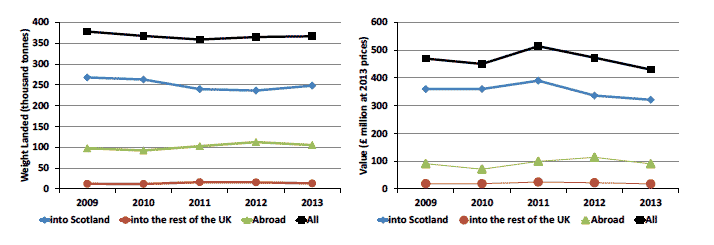
Landings by Scottish vessels accounted for 60 per cent of the value and 59 per cent of the quantity of all landings by UK vessels ( Tables 1.1.e and 1.1.o). Since 2012, these figures have increased by one and two percentage points respectively.
1.1.1 Demersal, pelagic and shellfish landings by Scottish based vessels
In 2013, 202 thousand tonnes of pelagic species were landed by Scottish vessels with a value of £153 million. This accounted for 55 per cent of all landings by Scottish vessels in terms of quantity and 36 per cent in terms of value. Demersal species represented 28 per cent of the quantity of all landings (102 thousand tonnes) and 32 per cent of the value (£140 million). Shellfish landings accounted for 17 per cent of landings by quantity (62 thousand tonnes) and 32 per cent by value (£137 million) ( Chart 1.2).
Chart 1.2 Quantity and value of landings by Scottish vessels; percentage of each species type, 2013.

The nine per cent reduction in the value of landings by Scottish based vessels between 2012 and 2013 was reflected in decreases in value across all species types ( Chart 1.3). In real terms the value of shellfish landings decreased by 14 per cent, pelagic species decreased in value by nine per cent, and demersal species value decreased by four per cent from 2012. In real terms the total reduction in value from 2012 is £43 million.
The factors for the reduction in value across the different species types was both the low prices obtained for key fish species (Chart 1.4) and also the decrease in landings in 2013 for key species. Just over half the total reduction in value ( -£22 million) is attributed to the loss in value of shellfish since 2012. In particular the value of Nephrops, which represents 15 per cent of the total value of Scottish landings in 2013 and 47 per cent of the value of shellfish landings, fell in real terms by 23 per cent (£19 million) from 2012. This is explained by the quantity landed decreasing by 13 per cent and the price decreasing by an 11 per cent, from £3,936 per tonne to £3,496 per tonne.
The value of pelagic species declined in real terms by £15.5 million since 2012. This reduction is attributed to a decrease in value for both mackerel and herring. Mackerel is the most valuable species to the Scottish fishing industry, accounting for 29 per cent of the total value of Scottish landings in 2013 and 82 per cent of the value of pelagic landings. The value of mackerel in real terms fell five per cent from 2012, with the quantity landed very marginally lower than 2012 at less than half of one per cent decrease. Mackerel value was reduced due to by a five per cent decrease in price, from £991 per tonne to £941 per tonne. Herring, which represents five per cent of the total value of Scottish landings in 2013 and contributes 15 per cent of the total pelagic landed species, decreased in value in real terms by 23 per cent, even though quantity landed was higher by six per cent since 2012. The price per tonne of herring decreased by 27 per cent, from £542 per tonne to £393 per tonne.
The value of demersal species decreased in real terms by just over £5 million since 2012. The value of monkfish, which represents five per cent of the total value of Scottish landings in 2013 and 15 per cent of the value of demersal landings, decreased in real terms by 26 per cent, a loss of £7 million in real terms, while the quantity landed decreased by 16 per cent. In contrast haddock which represents nine per cent of the total value of Scottish landings in 2013 and 28 per cent of the value of demersal landing, increased in real terms by 19 per cent, an increase of £6 million in real terms. This is because the quantity landed increased by 13 per cent and the price per tonne increased by five per cent, from £1,062 per tonne to £1,118 per tonne.
Chart 1.3 Quantity and value of landings by Scottish vessels by each species type; 2009 to 2013.
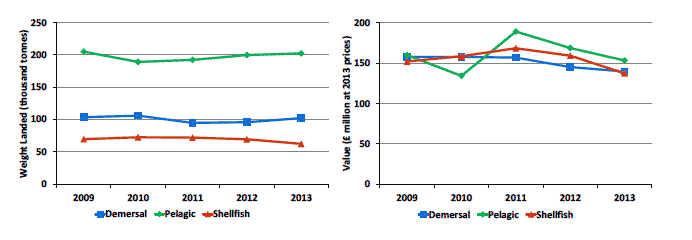
Chart 1.4 Percentage change from 2012 to 2013 in the real term price per tonne obtained for key fish species.
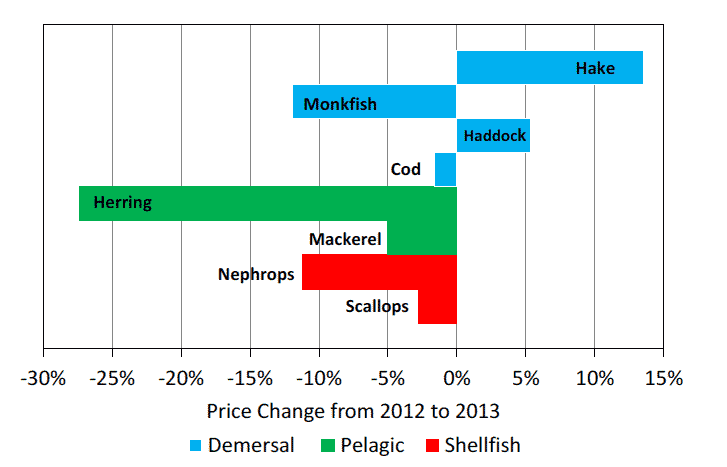
Prices of fish in 2013 and other years in real terms can be found in Table 1.1.x.
A breakdown of landings by Scottish vessels into Scotland, the rest of the UK, and abroad, by species are given in Tables 1.1.a to 1.1.e as well as corresponding figures for other UK vessels in Tables 1.1.f to 1.1.o, and figures for foreign vessels landings into the UK in Tables 1.1.p to 1.1.t.
Demersal fish
Demersal species contributed 32 per cent of the overall value of landings by Scottish vessels in 2013. In 2013 the total quantity of demersal species landed by Scottish vessels increased by seven per cent from 2012, although the value decreased in real terms by four per cent. Haddock, monkfish and cod are the three main demersal fish species landed by Scottish vessels in terms of value, accounting for 28 per cent, 15 per cent and 15 per cent respectively of all the demersal species landed in 2013. In terms of quantity landed by Scottish vessels, demersal species contributed 28 per cent of the overall quantity landed. Of all demersal species landed by Scottish vessels haddock accounts for 34 per cent, cod and saithe both 11 per cent, whiting ten per cent and monkfish seven per cent.
The value of demersal species decreased by four per cent from 2012, driven by reductions in value of various species including monkfish, hake and cod, which fell 26 per cent to £20.5 million, 11 per cent to £13.4 million and one per cent to £21.4 million, respectively ( Chart 1.5.a). The value of monkfish fell due to a combination of a 16 per cent decrease in the quantity landed and a 12 per cent decrease in price. Monkfish price per tonne decreased from £3,340 per tonne to £2,941 per tonne. The value of hake fell due to a 22 per cent decrease in the quantity landed, despite a 14 per cent increase in price, from £2,138 per tonne to £2,427 per tonne. Cod has a slight decrease in value of just over one per cent decrease in price and a slight increase in the quantity landed of less than half of one per cent. The effect of the reductions in value of monkfish, hake, cod and other demersal species on the overall demersal sector value, was buffered by the increase in value of haddock, which increased by 19 per cent. This increase in the value of haddock is due to an increase in price of over five per cent compared to 2012 ( Chart 1.4) from £1,062 per tonne to £1,118 per tonne and a 13 per cent increase in the quantity of haddock landed in 2013 from 2012, mainly due to an increase of North Sea quota for haddock.
From the real term prices per tonne only hake and haddock showed an increase in price from 2012 ( Chart 1.4).
Chart 1.5.a Quantity and value of landings of the key demersal species by Scottish vessels: 2009 to 2013.
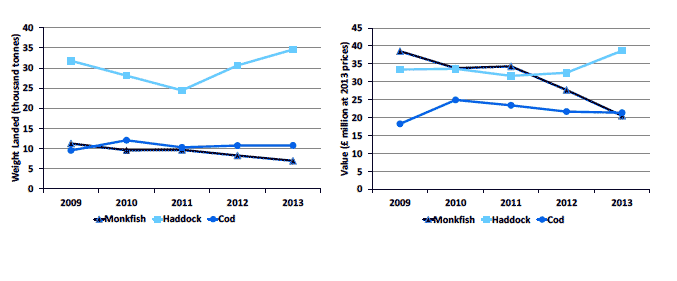
Pelagic fish
Mackerel and herring are the two main pelagic fish landed by Scottish vessels in terms of both quantity and value. In 2013 the total quantity of pelagic species landed by Scottish vessels increased by just over one per cent from 2012, however the value decreased in real terms by nine per cent. Mackerel, the stock with the largest landings by the Scottish sea fishing industry, accounted for 82 per cent of the value and 66 per cent of the quantity of all the pelagic landings by Scottish vessels in 2013. Herring accounted for 15 per cent of the value and 29 per cent of the quantity, of all the pelagic landings by Scottish vessels in 2013
From 2012 to 2013, the value of mackerel decreased by five per cent and the value of herring decreased by 23 per cent ( Chart 1.5.b). These changes in value were largely due to decreases in the prices per tonne in 2013. Whilst the quantity of mackerel landed reduced by less than half of one per cent, the price underwent a five per cent decrease, reducing the value of mackerel from £991 per tonne to £941 per tonne. The quantity of herring landed by Scottish based vessels in 2013 increased by six per cent. However the price underwent a 27 per cent decrease in price ( Chart 1.4), down from £542 per tonne to £393 per tonne.
Chart 1.5.b Quantity and value of landings of the key pelagic species by Scottish vessels: 2009 to 2013.
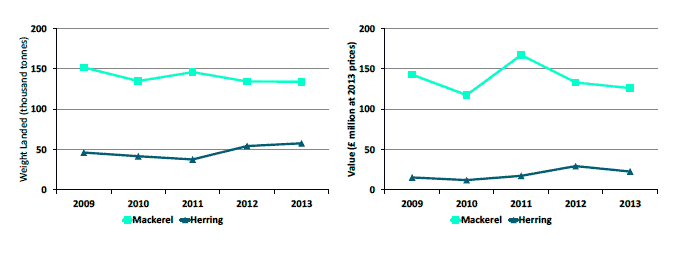
Shellfish
Nephrops and scallops are the two main species of shellfish landed by Scottish vessels. In 2013 the total quantity of shellfish species landed by Scottish vessels decreased by 10 per cent from 2012, and the value decreased in real terms by 14 per cent. Nephrops accounted for 47 per cent of the value and 30 per cent of the quantity of shellfish landed by Scottish vessels in 2013. Scallop landings accounted for 23 per cent of the value and 28 per cent of the quantity of all shellfish landings by Scottish vessels in 2013.
Nephrops is the most valuable shellfish species to the Scottish fishing industry, worth £64.6 million in 2013 and accounting for 15 per cent of the total value of all Scottish landings. The value of Nephrops landings by Scottish vessels decreased by 23 per cent in real terms from 2012. This decrease in value was driven by a 13 per cent decrease in the quantity landed (18.5 thousand tonnes). Furthermore, the price of Nephrops decreased by in real terms by 11 per cent from £3,936 per tonne in 2012 to £3,496 per tonne in 2013.
Scallops are worth £31.8 million in 2013 and accounting for seven per cent of the total value of all Scottish landings. The value of scallop landings in 2013 remained similar to that in 2012, decreasing by less than half of one per cent. The quantity of scallop landings increased by three per cent since 2012, but that was offset by a three per cent decrease in the price from £1,862 per tonne in 2012 to £1,810 per tonne in 2013.
Squid, lobsters, velvet crabs and Queen Scallops all reduced considerably in terms of value and weight landed between 2012 and 2013. Edible crab weight landed remained fairly constant from 2012, and the value increased by two per cent. Queen scallops experienced the greatest changes between 2012 and 2013 with decreases of 31 per cent in terms of quantity landed and 16 per cent in terms of value landed. However the price rose by 22 per cent in real terms, the largest price rise in all the key species, from £407 per tonne to £496 per tonne since 2012. Velvet crab also experienced decreases of 23 per cent in terms of quantity landed and 19 per cent in terms of value landed. The price rose by four per cent in real terms, from £2,429 per tonne to £2,531 per tonne since 2012.
Chart 1.5.c Quantity and value of landings of the key shellfish species by Scottish vessels: 2009 to 2013.
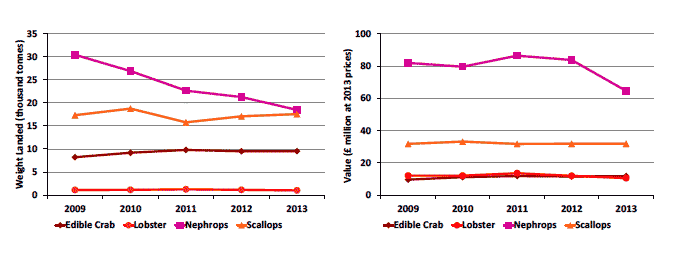
1.2 Landings abroad by Scottish based vessels
In 2013, Scottish vessels landed 105 thousand tonnes of fish abroad with a corresponding value of £90 million. Despite the slight increase in the quantity of the total fish landed by Scottish vessels, the quantity of landings abroad decreased by six per cent and the value of landings abroad decreased by 21 per cent in real terms since 2012 ( Table 1.1.d and 1.3). Apart from Denmark and Netherlands, landings by Scottish vessels into all other countries have decreased both in quantity and value during 2013.
Landings abroad accounted for 29 per cent of all landings by Scottish vessels in terms of quantity and 21 per cent in terms of value. Of this, 85 per cent of the quantity of landings abroad was pelagic, 14 per cent were demersal and less than one per cent were shellfish. The main species landed abroad was mackerel, contributing £59.9 million, and representing 66 per cent of the total value of fish landed abroad. However mackerel landings abroad have decreased in quantity by 17 per cent and decreased in value (real terms) by 20 per cent since 2012. There were 59.8 thousand tonnes (45 per cent) of mackerel landed abroad by Scottish vessels, compared to 74.2 thousand tonnes (55 per cent) landed into the UK by Scottish vessels in 2013. The price for mackerel landed into the UK in 2013 was, on average, £892 per tonne, while mackerel landed abroad received an average of £1,003 per tonne.
The majority of Scottish landings abroad are into Norway, and nearly all of these landings are pelagic species. In 2013, 82 per cent of the value of landings into Norway was for mackerel amounting to 52.6 thousand tonnes with a value of £52.3 million. In 2013, Scottish vessels landed 14.7 thousand tonnes of demersal species abroad with a value of £14.8 million. The key countries for demersal landings are Denmark, Netherlands, Ireland and Spain. Only 0.8 thousand tonnes of shellfish was landed abroad by Scottish vessels in 2013, mainly into Ireland.
Figure 1.1.a Quantity of landings abroad by Scottish vessels by country of landing: 2013 (tonnes).
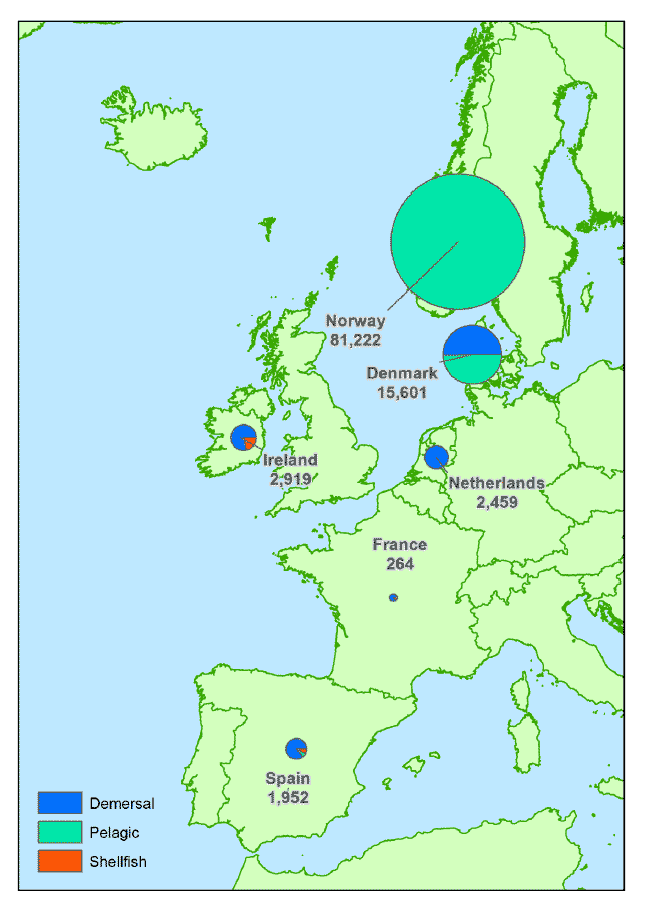
Figure 1.1.b Value of landings abroad by Scottish vessels by country of landing: 2013 (£' thousands).
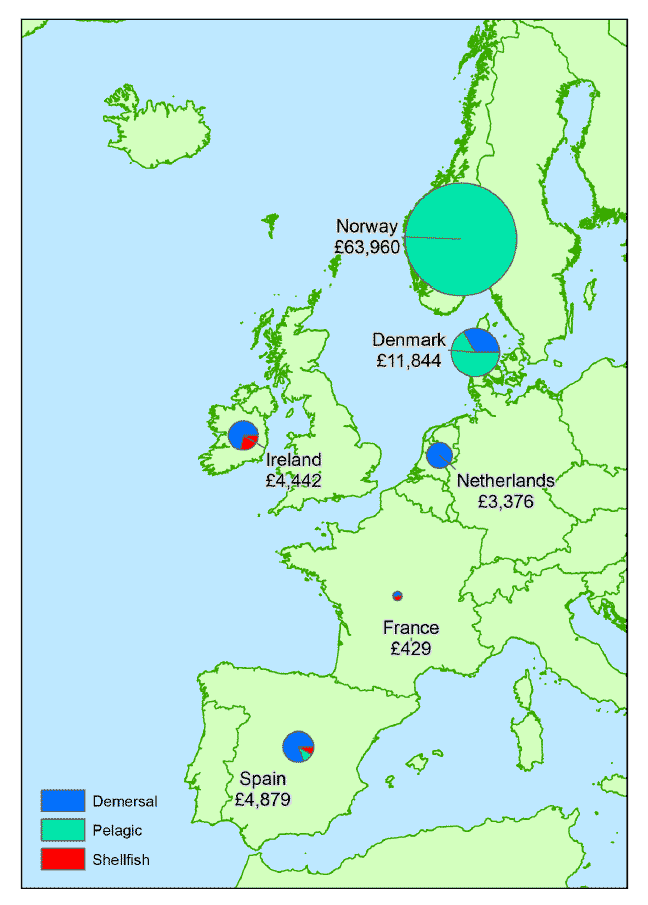
1.3 Landings by area of capture
The two main ICES areas that Scottish vessels were most active in during 2013 were the Northern North Sea ( ICES division IVa) and the West Coast of Scotland ( ICES division VIa) (Figures 1.2.a and 1.2.b). In the Northern North Sea IVa, 179 thousand tonnes of fish were caught with a value of £204 million, representing 47 per cent of the value of all landings by Scottish vessels ( Table 1.6). Just under a third of landings by Scottish vessels (32 per cent) in terms of quantity were caught in the West Coast of Scotland (VIa), providing 34 per cent of the total value of all Scottish landings.
Sixty six per cent of the quantity of all demersal landings by Scottish vessels, and 48 per cent of pelagic landings, were caught in the Northern North Sea. In the West Coast of Scotland a similar quantity of pelagic species (82 thousand tonnes) were caught, but more shellfish species were caught in the West Coast than in the Northern North Sea. In terms of quantity shellfish catches from the West of Scotland accounted for 38 per cent of all shellfish catches. The Central North Sea (ICES division IVb) and the Irish Sea (VIIa) are also areas of considerable activity for shellfish fisheries. Nineteen per cent of shellfish catches are from the Irish Sea whilst 12 per cent are from the Central North Sea. Almost all catches from the Irish Sea are of shellfish species, with a total value of £10.2 million. Six per cent of all catches were caught in the rest of Area VII ( i.e. not the Irish Sea). This area has reasonable activity from demersal, pelagic and shellfish vessels.
Further maps of fishing activity in the seas around the UK by Scottish vessels, other UK vessels, and foreign vessels that land into the UK will be available on the ICES rectangle webpage on the Scottish Sea Fisheries Statistics website. These maps show the quantity and value of landings by species type by ICES rectangle.
Figure 1.2.a Quantity of landings by Scottish vessels by area of capture: 2013 (tonnes).
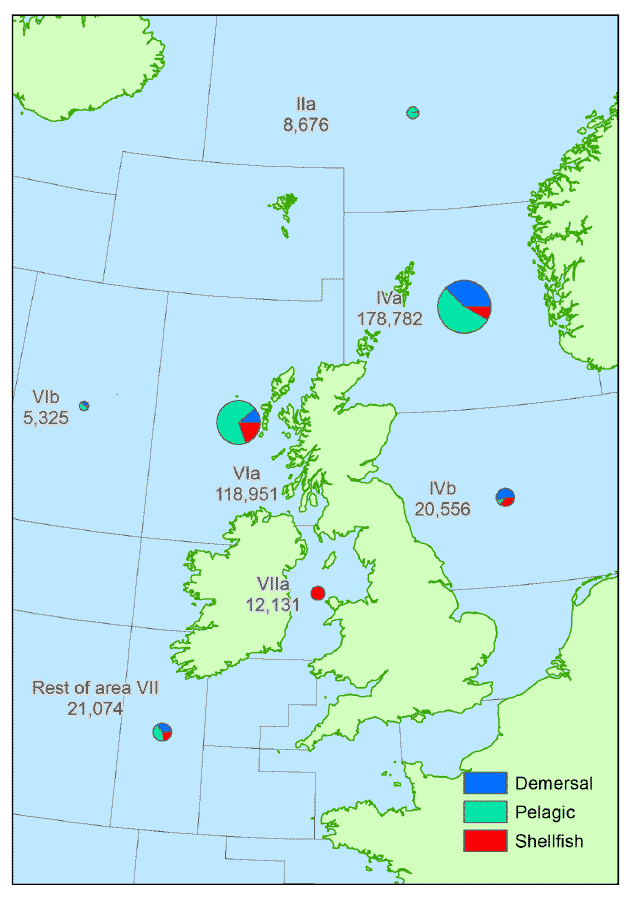
Figure 1.2.b Value of landings by Scottish vessels by area of capture: 2013 (£'thousand).
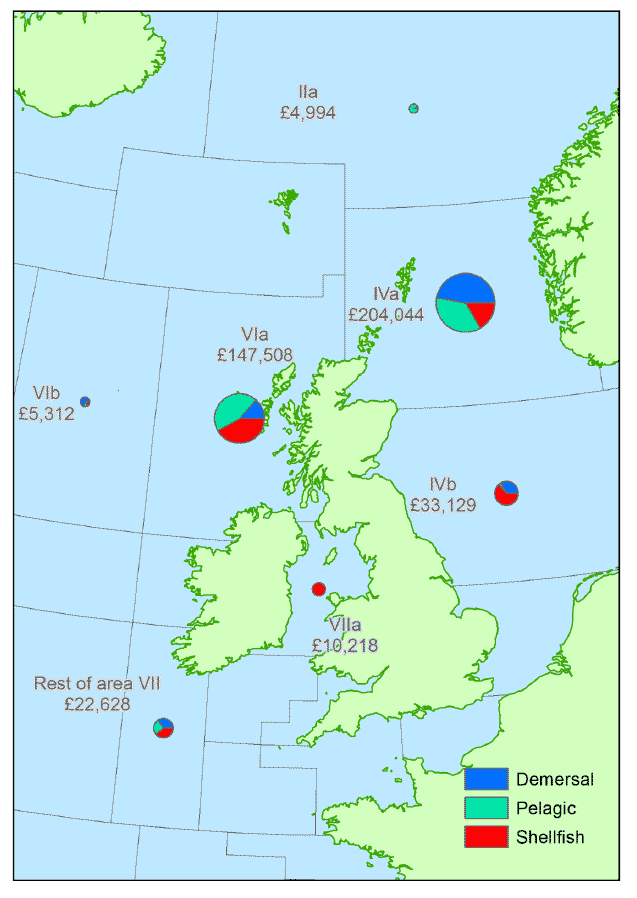
1.4 Landings into Scotland
In 2013, there were 313 thousand tonnes of sea fish and shellfish landed into Scotland with a value of £400 million. This is a decrease of five per cent since 2012 both in terms of quantity and value. Landings of demersal species contributed 43 per cent, shellfish contributed 31 per cent and pelagic 26 per cent in terms of value to the total value of all landings into Scotland. However, in terms of quantity, 46 per cent of landings into Scotland were pelagic, 37 per cent were demersal and 17 per cent were shellfish species. The differences in how each species type contributed to the total value and total quantity of landings into Scotland highlight the differences between the prices per tonne across the species types. Shellfish receive relatively high prices per tonne, whilst pelagic species receive lower prices per tonne ( Table 1.1.s).
Figure 1.3.a and b and Table 1.7 show landings by all vessels by species type into the eighteen Scottish districts. Landings into the south-west coast and south-east coast were dominated by shellfish, while landings into the north-west coast constituted both demersal and, to a lesser extent, shellfish species. The three largest districts in Scotland in terms of landings were Peterhead (east coast), Shetland (north) and Fraserburgh (east coast). These districts receive landings of all three species types, but Peterhead and Shetland receive relatively small amounts of shellfish compared to demersal and pelagic species.
Combined, the top three districts accounted for 73 per cent in quantity and 58 per cent in value of all landings into Scotland. One hundred and thirty thousand tonnes, worth £124 million, were landed into Peterhead. In terms of quantity, 57 per cent of the landings were pelagic accounting for 39 per cent of landings value into Peterhead. In contrast 41 per cent of the quantity of the landings were demersal accounting for 55 per cent of the value into Peterhead. Landings into Shetland totalled 74 thousand tonnes at a value of £74 million. In terms of quantity, 75 per cent of the landings were pelagic accounting for 60 per cent of landings value into Shetland. Twenty three per cent of the quantity of the landings were demersal accounting for 34 per cent of the value into Shetland. Shellfish accounted for three per cent of the quantity landed in Shetland and accounted for five per cent of the value. In contrast, the third biggest district, Fraserburgh, was dominated by shellfish landings, representing just under half the value of the landings (48 per cent). In terms of quantity, about half of landings into Fraserburgh were pelagic species and 22 per cent were shellfish landings.
Figure 1.3.a Quantity of landings into Scotland by all vessels by district: 2013 (tonnes).
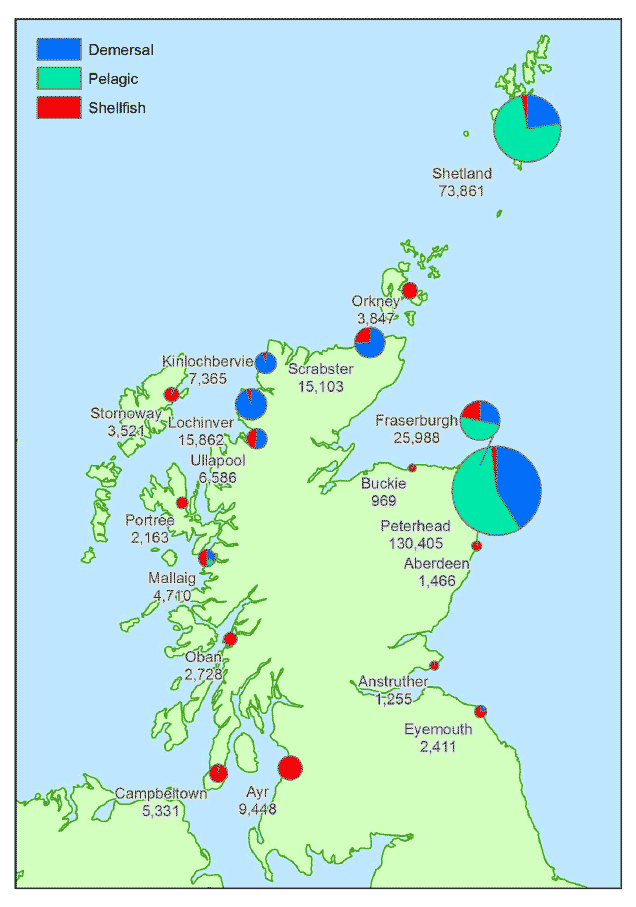
Figure 1.3.b Value of landings into Scotland by all vessels by district: 2013 (£'thousand).
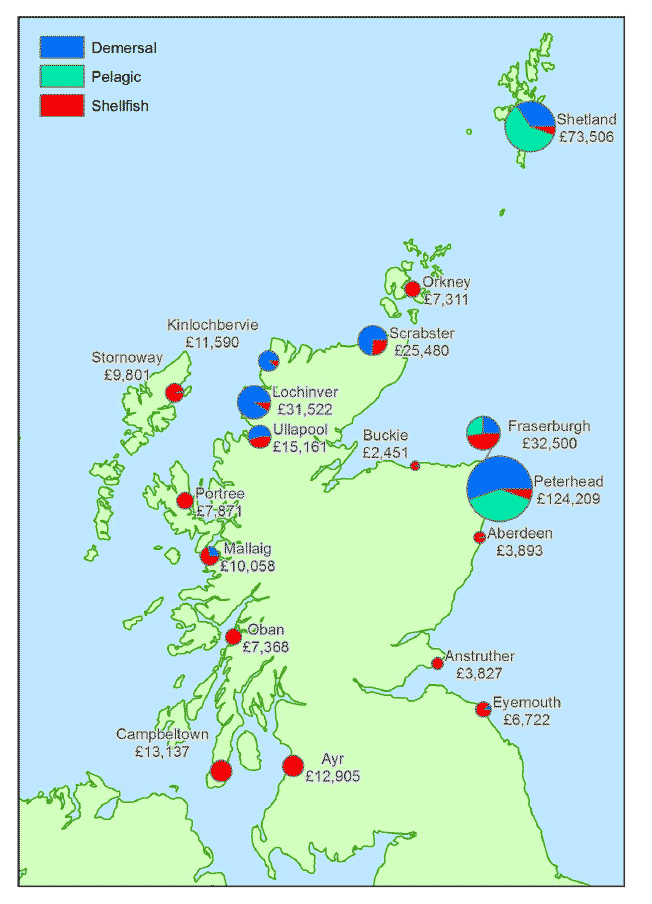
1.5 Total allowable catches quota and uptake
Table 1.10 shows the total allowable catch ( TAC) for stocks. TACs are a catch limit set for individual stocks and are fixed on an annual basis at international negotiations. Some stocks are managed and fished only by European Union ( EU) member states and the TAC for these are set by the European Commission through internal negotiations between those EU member states with an interest. Other stocks are managed and shared with non- EU states and TACs for these are set at separate negotiations with interested parties, particularly Norway, Iceland, the Faroes Islands and the Russian Federation (the 'Coastal States').
The EU TAC is shared among EU member states based on a number of factors, including each member state's past catch record. This share, known as quota, is displayed in Table 1.10 at the UK and at the Scottish Producers Organisations ( POs) level. The quantity and percentage uptake of this quota is also given for each stock in Table 1.10.
Chart 1.6 compares the quota uptake of important demersal and pelagic stocks in Scottish Producer Organisations in 2013 and 2012. North Sea haddock and saithe exceeded 99 per cent quota uptake in 2013. North sea cod reached 99 per cent and North Sea Whiting reached 96 per cent. North Sea Nephrops and monkfish quota uptake was relatively low, at 48 per cent and 65 per cent, respectively. At the end of 2013, North Sea Nephrops uptake was six percentage points below what it was in 2012. This is an outcome of the poor Nephrops availability in the Fladens in that year. The West of Scotland demersal stocks had generally lower quota uptakes than North Sea stocks, which is not out of the ordinary. Quota uptake exceeded 100 per cent for most of the pelagic stocks. The West of Scotland Herring quota uptake was 95 per cent in 2013.
Chart 1.6 Quota uptakes of important stocks by vessels in Scottish POs in 2013 and 2012.
Demersal stocks
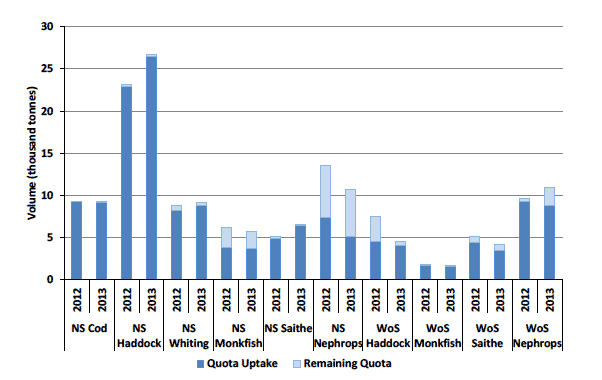
Pelagic stocks
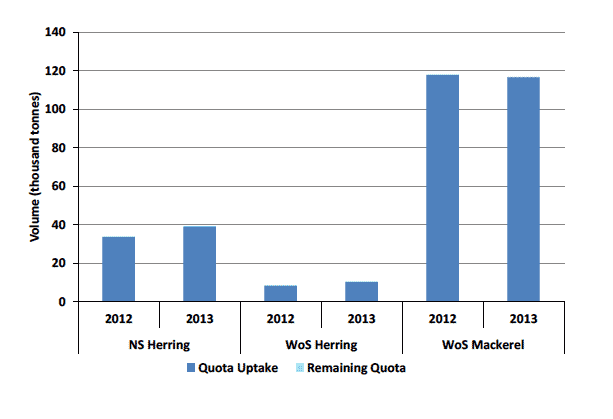
Contact
There is a problem
Thanks for your feedback